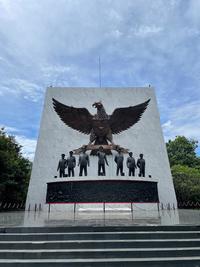
The Sacred Pancasila monument (Credit: Fiona Asokacitta)
In her entry in The Palgrave Encyclopedia of Cultural Heritage and Conflict doctoral student Fiona Asokacitta describes how the controversial Cold War era anti-communist site, the Sacred Pancasila Monument and Museum, serves as a poignant case study of the role of museums and monuments in shaping the collective history of a traumatic national event.
Colloquially known as the Crocodile Pit [Lubang Buaya], the Sacred Pancasila Monument and Museum in Jakarta Indonesia officially commemorates the failed Indonesian Communist Party [Partai Komunis Indonesia] (PKI) coup of 1965. The failed coup became the pretext for the elimination of the PKI, the rise of the authoritarian New Order regime under President Suharto and the deaths of up to a million people accused of being affiliated with the communist party.
Fiona Asokacitta examines how the Sacred Pancasila Monument and Museum manifested, reinforced and perpetuated the propaganda of the New Order regime and the role it continues to play in Indonesia more than 25 years after Suharto was ousted from power.
Having visited this field site over the course of five years, I am pleased to see the fruits of my observations emerge in this chapter. As many nations around the world, including Indonesia, return to increasingly illiberal policies, I find it imperative as an anthropologist to examine how cultural institutions shape national memory making, and how they in turn contribute to these current political shifts.
Fiona Asokacitta
Read the entry in full